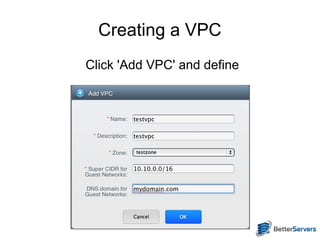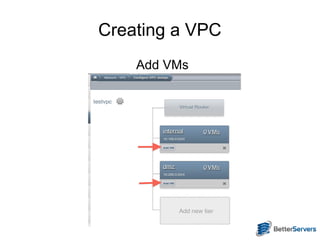Implementing CloudStack's VPC feature
- 1. Implementing CloudStack's VPC feature Marcus Sorensen BetterServers, Inc
- 2. CloudStack 3.x network VMs on a network
- 3. CloudStack 3.x network VMs on multiple networks
- 4. CloudStack 3.x network VMs w/NAT router on networks
- 5. CloudStack 3.x network No inter-vlan communication for customer's private networks
- 6. What's a VPC? ● Has multiple meanings ● In CloudStack, a VPC is: – A virtual router – One or more isolated networks – One or more virtual machine instances – Associated services ● ACLs ● Source NAT ● Static NAT ● Port Forwarding ● Load balancing ● VPN
- 7. CloudStack 4.x VPC VPC router provides inter-vlan access
- 8. VPC Router ● Debian-based system VM ● CloudStack controlled/configured ● HAProxy load balancer ● iptables rules for ACLs, NAT, port forwarding ● 1 NIC one each isolated network, one on public ● Gives customers a full datacenter experience
- 9. Creating a VPC Find the VPC section
- 10. Creating a VPC Click 'Add VPC' and define
- 11. Creating a VPC Once VPC is created, click 'configure VPC'
- 12. Creating a VPC Create one or more tiers
- 13. Creating a VPC Add VMs
- 14. Creating a VPC Create ACLs, get more IPs, etc
- 15. Current Limitations ● Advanced Zones only ● Load Balanced service offering only available on one of your isolated networks ● Only one NIC/isolated network per VM instance ● Need to acquire separate IPs for Static NAT, Port forwarding, etc ● Only Site to Site VPN, no remote access VPN ● No redundant router mode
- 16. Advanced: Roll your own VPC ● Create an instance ● Attach to multiple isolated networks and a public network ● Configure instance as router ● Create template of instance to deploy subsequent routers

















